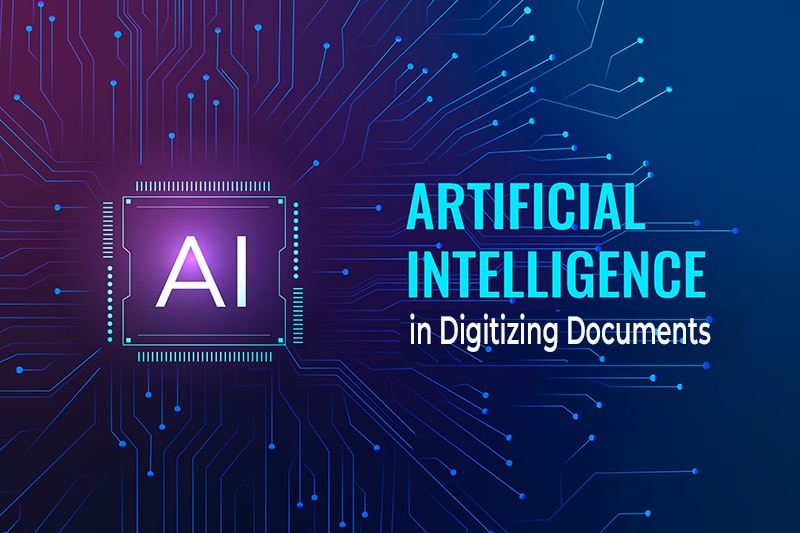In order to succeed in this rapidly competitive business environment, businesses need to get fully equipped or ready to embrace change. Today, businesses have moved a long way from traditional document management systems, which simply involve saving all the files, folders, documents and images in a specific location. Today, document and data processing services leverage artificial intelligence (AI), which has transformed the way documents are processed and managed.
Regarded as one of the fastest-growing technology trends worldwide, Artificial Intelligence (AI) is used virtually in every facet of work today. The radical shift is opening up new opportunities for small businesses to get a foothold in the market. According to a Statista report, the global artificial intelligence for businesses’ market size has grown to a value of $327.5 billion. By 2024, it is expected to cross $554.3 billion in global revenue. Artificial Intelligence is the future of value-added chain operations in a business and it helps to optimize work processes.
Using Artificial Intelligence for Document Digitization
According to a study published by Xerox, 46 percent of survey respondents stated that they waste a considerable amount of time due to excessive paperwork. Regardless of this aspect, only about 50 percent of companies have started to implement digital processing, or still consider doing so. When compared to paper documents, digital files have several advantages. State-of-the-art data processing technology is capable of optimizing document digitization via artificial intelligence (AI) and machine learning. In fact, companies that do not utilize the benefits of these opportunities can quickly fall behind.
The benefits of digitizing a company’s documentation are numerous. Converting paper documents to PDF files for archiving has been a common practice for years. This is where AI technology is now being utilized to convert them into data sources. Fiscal records, contracts, communications, invoices, and any other documents related to the type of business are filed in every firm. Document digitization is widely used to make physical spaces more efficient.
Benefits of Using Artificial Intelligence for Document Digitization
The following are some of the benefits of using artificial intelligence for document digitization –
- Improves OCR Accuracy – AI and the self-learning function for document digitization help to dynamically enhance the software’s capacity to convert pictures into accurate text that fully matches the original format. Standard OCR software frequently makes errors while extracting text based on factors such as the quality of the original document, the kind of paper, the markings on the copy, and the existence of lines or boxes. For instance, a conventional OCR system cannot recognize the location of text in projects, blueprints, or forms but an AI-driven OCR platform can recognize the same.
- AI-assisted Identification of Documents – The ability to evaluate cohesive headers, headings, sections, and portions thematically is possible by determining the logical structure. This adds value to the writings by enabling the extraction of essential data, indexing, automatic filing, and the detection of linkages between related texts.
Process of Document Digitization
Document digitization by utilizing AI technology may offer new value and innovation in diverse business areas. Experts say that artificial intelligence is mainly used to automate repetitive operations and analyze vast volumes of data. Document digitization in the workplace, along with AI and ML algorithms, helps in the simplification of the company’s most essential procedures. In any business environment, there are significant volumes of high-value paper documents like – medical records, tax documents and invoices, contracts, notary and law firm paperwork – that need to be converted to digital format in various situations. AI technology can be leveraged to extract useful information from scanned papers.
Automated Document Generation – Generally, a significant amount of time is wasted in creating new versions of existing documents. For instance, when new employees tend to join a company, they have to comply with a number of guidelines that regulate the company’s internal working environment. All this can be accelerated by automating documents through artificial intelligence and machine learning.
The process of document digitization follows a series of steps-
- Digital Scanning – This is the first step of digitization; digital scanning can make valuable changes in business organizations. In simple terms, document scanning involves the process of capturing digital images of paper documents. The images of the physical documents are then transformed into a digital format using OCR conversion software. OCR, or optical character recognition, scans document images and turns them into text documents. This intelligent conversion allows documents to be searched with relevant keywords. High-quality scanners scan large numbers of documents in one go and thereby reduce costs. Thus bulk document scanning improves the credibility of business processing.
- Optical Character Recognition – Optical character recognition or OCR is the process of turning a scanned picture into text. Once the paper document has been scanned, it needs to be converted into text using specialized software. The OCR identifies whether a combination is a specific sign or a letter of the alphabet by studying the lines and curves of the image, converting the scan into a text file.
- Data Extraction and Analysis – AI algorithms can collect data and important information, comparing it with various document patterns. Companies are thus able to extract specific data from their documents. This applies not only to document’ content, but also to documents in general. For instance, you can obtain information about how many documents of a certain type are available. You can track document usage and other key figures in order to identify changing patterns and trends. In addition, future integration with automatic invoicing is also possible. Employees can thus concentrate on their main work and be relieved of tedious routine tasks such as creating documents. The process of data extraction and analysis involves the following steps –
- Automatic creation of new versions of existing documents
- Extracting specific data from documents
- Tracking various indicators, which provide a clear understanding of the changing patterns and trends
- Instant update/change of information in all documents that are grouped according to different criteria
- Working hours will be used optimally, administrative efforts will be reduced
- Classification and Processing – With AI and machine learning algorithms, data can be extracted for other purposes. For instance, the context of content can be analyzed and captured automatically. Documents can be easily divided into groups or sorted by date, subject, subject area, etc. Document management software uses optical character recognition to read text content. This in turn reduces the time required for manual processing and makes it easier to find documents once they have been digitized.
- File Administration – Digital file management is often done using a Document Management System (DMS) platform. This platform provides effective digital document management through safe search and archiving functionalities, even in the cloud.
In the digital era, digitized documents hold the key to competitive business progress. Scanned documents can save both time and money, and can be stored more securely. The use of AI to digitize documents has great potential. The integration of corporate processes is one of the benefits of digitizing documents using artificial intelligence platforms. Document digitization services provided by professional data conversion companies also enables the management and employees to concentrate on their core tasks. With AI-powered tools and technologies, business organizations can ensure accurate data and get their data infrastructure ready for the best utilization of AI document management and processing.




